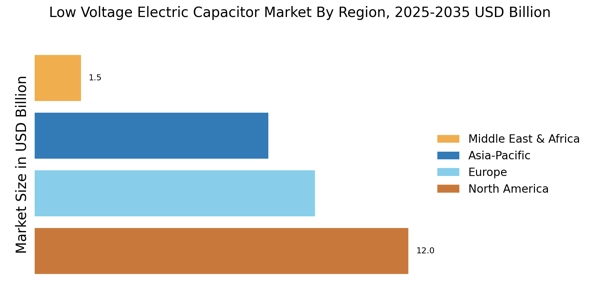Surge in Consumer Electronics
The surge in consumer electronics is another significant driver for the Low Voltage Electric Capacitor Market. With the proliferation of devices such as smartphones, tablets, and wearable technology, the demand for compact and efficient capacitors has escalated. The consumer electronics sector is projected to witness a growth rate of approximately 5% annually, which directly correlates with the increasing need for low voltage capacitors. These components are essential for power management and signal processing in electronic devices, thereby enhancing performance and longevity. As manufacturers strive to meet consumer demands for more advanced and energy-efficient products, the Low Voltage Electric Capacitor Market is likely to experience substantial growth.
Growth in Industrial Automation
The growth in industrial automation is a critical driver for the Low Voltage Electric Capacitor Market. As industries increasingly adopt automation technologies to enhance productivity and efficiency, the demand for reliable power management solutions rises. Capacitors are essential in various automation applications, including motor drives and control systems, where they help maintain voltage stability and improve power quality. The industrial automation market is anticipated to grow at a rate of approximately 8% annually, which bodes well for the Low Voltage Electric Capacitor Market. This growth reflects a broader trend towards digitization and smart manufacturing, where capacitors play a vital role in ensuring the seamless operation of automated systems.
Expansion of Smart Grid Technologies
The expansion of smart grid technologies significantly influences the Low Voltage Electric Capacitor Market. Smart grids enhance the efficiency and reliability of electricity distribution, necessitating the use of capacitors for voltage regulation and power factor correction. As utilities invest in modernizing their infrastructure, the demand for low voltage capacitors is expected to rise. Reports suggest that investments in smart grid technologies could reach trillions of dollars over the next decade. This investment trend indicates a robust growth trajectory for the Low Voltage Electric Capacitor Market, as capacitors are integral to the functionality of smart grids, ensuring stable and efficient energy distribution.
Increasing Adoption of Electric Vehicles
The rising adoption of electric vehicles (EVs) is a pivotal driver for the Low Voltage Electric Capacitor Market. As the automotive sector transitions towards electrification, the demand for efficient energy storage solutions intensifies. Capacitors play a crucial role in managing power supply and enhancing the performance of EVs. According to recent estimates, the EV market is projected to grow at a compound annual growth rate of over 20% in the coming years. This surge in EV production necessitates advanced capacitor technologies, thereby propelling the Low Voltage Electric Capacitor Market forward. Furthermore, the integration of capacitors in charging infrastructure supports the overall efficiency of EV systems, indicating a symbiotic relationship between the two markets.
Regulatory Push for Energy Efficiency Standards
Regulatory frameworks aimed at enhancing energy efficiency are driving the Low Voltage Electric Capacitor Market. Governments worldwide are implementing stringent energy efficiency standards across various sectors, including industrial, commercial, and residential applications. These regulations often mandate the use of energy-efficient components, including capacitors, to reduce energy consumption and greenhouse gas emissions. The market for low voltage capacitors is expected to expand as industries comply with these regulations. For instance, the implementation of energy efficiency programs could lead to a market growth rate of around 6% annually. This regulatory push not only fosters innovation in capacitor technology but also solidifies the role of the Low Voltage Electric Capacitor Market in achieving sustainability goals.


















Leave a Comment